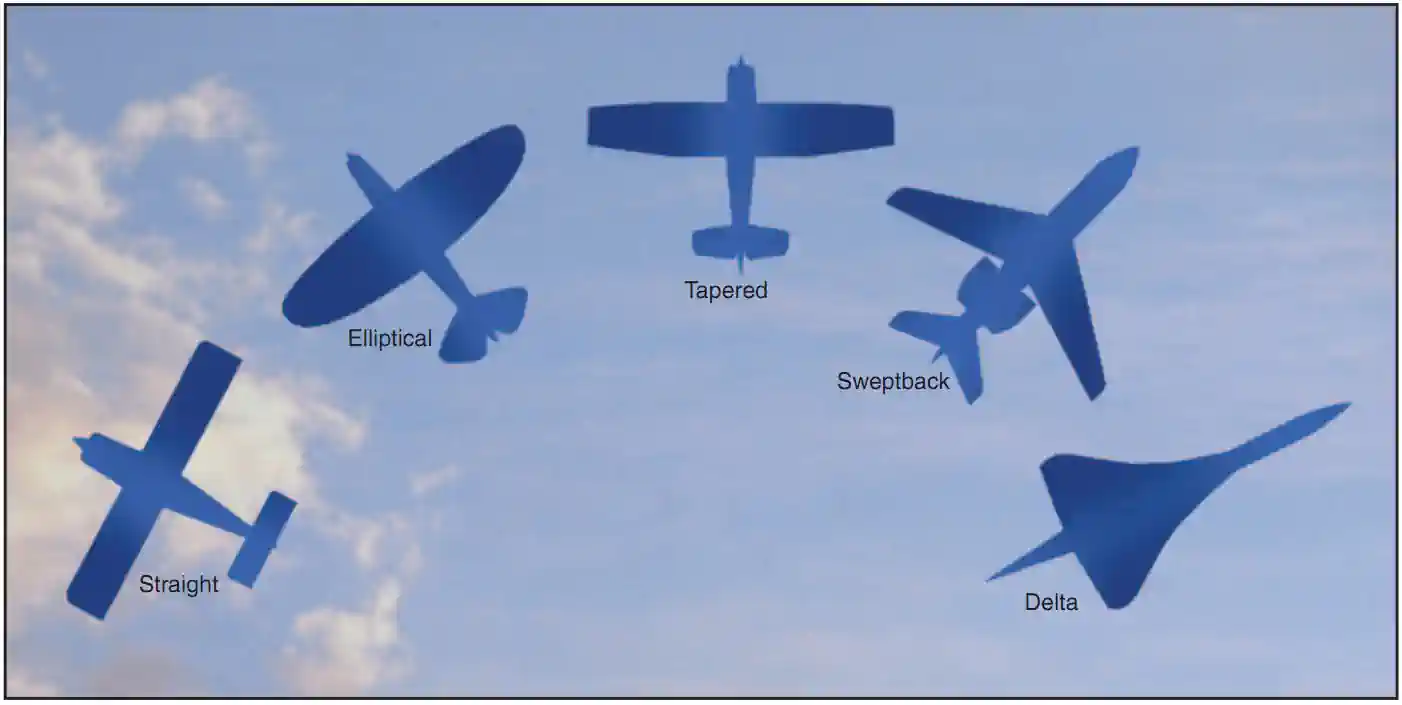Shape Of Airplane Wing - Examples of wings in nature and in or on different cars. The dolphin in the bottom left obeys the same principle in a different water; it is an example of a hydrofoil.
An airfoil (American glish) or hydrofoil (British glish) is a part of the body whose movement by gas can produce a dramatic lift, like an airplane. B. the wings, sails or blades of a propeller, rotor or turbine.
Shape Of Airplane Wing

A solid body moving through a liquid creates wind energy. The component of this horizontal force is called the velocity without respect. An individual property that loses speed is called drag. An airfoil is a flexible structure that can produce more lift than drag.
Airplane Wing Diagram Images, Stock Photos & Vectors
Airfoils can be tailored for use at different speeds by changing their geometry: those designed for subsonic flight generally have a rounded front face, while those designed for supersonic flight are slightly more rounded. have a sharp forehead. They all have sharp edges. Foils with a similar function in water are called hydrofoils.
The lift of the air is mainly from its combat side. Being in the right direction, the wind deflects the oncoming air (in fixed-wing aircraft, ground force), causing the force in the wind to the other side of the turn the body. This force is known as aerodynamic force and can be broken down into two types: lift and drag. Most types of foils require a positive angle of attack to produce lift, but a chambered wing can achieve lift with zero angle of attack. This "twisting" of the air near the airfoil creates reversed streamlines, resulting in low pressure on one side and high pressure on the other. This different pressure is accompanied by different velocities by Bernoulli's principle, as a result of which the surrounding air has a higher velocity at higher altitudes than on the ground. In some cases (for example, buoyancy force), the buoyancy force can be related to the average velocity difference between the surface and the bottom without calculating the pressure, using the theory of diffusion and Kutta-Joukowski theorem.
Cross sections are used to construct the wings and wings of airplanes and the rotor blades of helicopters. Air is also found in conveyors, fans, compressors and turbines. Sails are also wings, and the surface of the water under the ship, as. B. Cterboard, rudder and keel, have similar cross sections and work on the same principle as wings. Floating and flying creatures and many plants and organisms use hydrofoils: the most common examples are the wings of birds, the body of fish, and the shape of the sand dollar. Airfoil wings can reduce downforce and improve traction on a car or other vehicle.
When wind blocks an object such as a flat slab, building, or the surface of a bridge, the object experiences drag and also wind-dependent force. This does not mean that the material qualifies as air conditioning. Airfoils are a highly efficient form of lift, capable of producing more lift than flat airfoils of the same area, and capable of producing lift with little drag. Aircraft are used to build airplanes, propellers, rotor blades, wind turbines and other wind instruments.
Aircraft Components & Structure
The lift and drag curves obtained from the wind tunnel analysis are shown on the right. The curve represents an airfoil with good camber, so some of the free attack angle is raised. As the angle of attack increases, lift increases in a vertical relationship called the slope of the lift curve. At about 18 degrees, the profile stops and the lift drops off faster than that. The failure of the elevator can be explained by the behavior of the upper limit of the upper limit, which separates and rises significantly above the upper level and behind the corner of the store. The displacement thickness of the boundary layer changes the quality of the air flow, reducing its effective camber, which causes the overall flow area to decrease to reduce the spread and lift. The thick layer also causes a large increase in compression ratio, so that the total drag increases significantly near the outlet and beyond.
Air conditioning is an important part of air conditioning. Different wings provide different flight patterns. An asymmetric profile can increase lift in the free attack area, while a symmetric profile can be better for an aircraft that turns frequently such as an airplane. In the area of the ailerons and near the wings, a symmetrical profile can be used to increase the number of attack angles to avoid skid stalls. Therefore, large parts can be used without too many layers. The subsonic profile has a leading edge around it, which is independent of the attack angle. However, the cross section is not a normal circle: the radius of curvature is increased before the wing reaches the maximum thickness to reduce the chance of extreme separation. This lengthens the wing and moves the area of maximum thickness back from the main edge.
Supersonic wings have an angular shape and can have sharp edges that are very sensitive to attack angles. A supersonic airfoil has its mass close to the edge of the head so that it has enough length to slowly return from supersonic speed to subsonic speed. In general, such transonic airfoils, as well as supersonic airfoils, have a small curvature to reduce drag. Modern airplane wings can have different air flow sections along the wing, each suitable for the conditions in each area of the wing.

Lifting devices, flaps and sometimes slats, are attached to the wings of almost all aircraft. The accompanying flap acts similarly to an aileron; However, unlike an aileron, it can be retracted into the wing when not in use.
Nasa's Weird Wing Design Could Lead To Futuristic, Fuel Efficient Airplanes
A laminar discharge vane has a maximum thickness and central camber line. Analysis of the Navier-Stokes equation in the linear section shows that a decrease in negative pressure along the fluid has the same effect as a decrease in velocity. Therefore, with maximum camber in the center, it is possible to maintain laminar speed over a large percentage of the wing at high cruise lengths. However, some impurities on the surface disrupt the laminar process and cause it to spin. For example, when it rains on the wing, the water that flows will circulate. Under certain conditions, insect larvae and feathers also cause the loss of a small portion of the laminar fluid.
Prior to NASA's research in the 1970s and 1980s, the aircraft design community realized from World War II application testing that laminar wing designs had design tolerances and surface imperfections that were ineffective. This belief changed when new production methods and components were developed (for example, the laminar profile developed by Professor Franz Wortmann for use in wings made of plastic). A wrought iron system was also introduced. NASA research in the 1980s demonstrated the effectiveness and usefulness of the laminar wing design and opened the way for the application of laminar flow in modern aviation, from full-size aircraft to transonic supersonic aircraft.
Systems have been developed to define air flow - an example is the NACA system. Various air conditioning systems are also used. An example of an aerodynamic target that was commonly used in the pre-NACA system was the Clark-Y. Airfoils can be programmed for specific tasks using computer programs.
Some important factors to define the shape of a wing are its camber and its thickness. For example, the NACA airfoil system has four numbers such as NACA 2415 (counted as 2 - 4 - 15) which describes an airfoil with a camber of 0.02 located at 0.40 chords with a 0.15 column thickness.
How Aircraft Wings Are Made
Low airfoil theory is a simple airfoil theory that relates the attack angle to lift for incompressible, invisible speed. It was developed by the German mathematician Max Munk and refined by the British astrophysicist Hermann Glauert and others.
In the 1920s. This theory makes it flow around the atmosphere like a two-dimensional flow around a thin layer of air. You can think of it as a profile with zero thickness and infinite wingspan.
The theory of critical air flow was famous in its time because it provided a strong theoretical basis for the important properties of air flow in two-dimensional inviscid flow:

(The above statement also applies to a cambered profile, where α is the angle of attack measured on the zero-lift line rather than the line mark.)
How The Wing Flies?wing Aerodynamics
Also due to (3), the lift coefficient of a curved airfoil of infinite length is:
Where c l 0}} is the lift coefficient of the angle when the angle of attack is zero.
The thin airfoil theory does not account for airfoil room, which usually occurs at an angle of attack between 10° and 15° for the airfoil.
However, in the mid-2000s, Wallace J. Morris II proposed an idea in his book that predicted the beginning of the supermarket chain.
How Nasa Tests Shapeshifting Plane Wings
Shape of an airplane wing, parts of airplane wing, wing of airplane, wing airplane, shape airplane, shape of airplane, airplane wing shape, airplane wing lights, airplane wing shape airflow diagram, shape of an airplane, wing of an airplane, shape of a wing
0 Comments